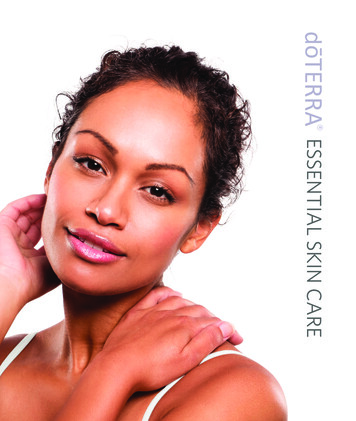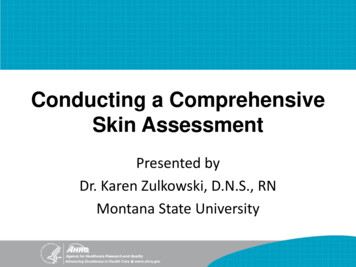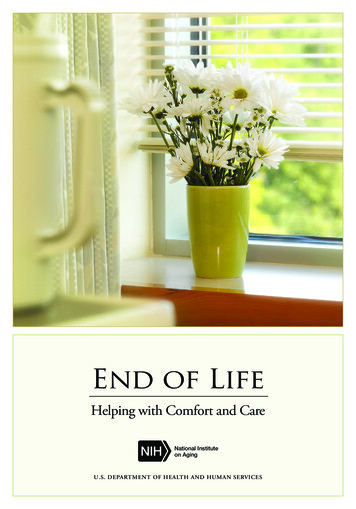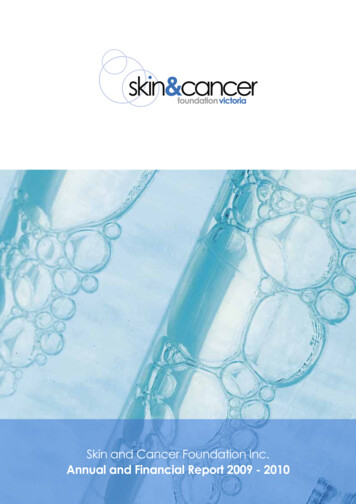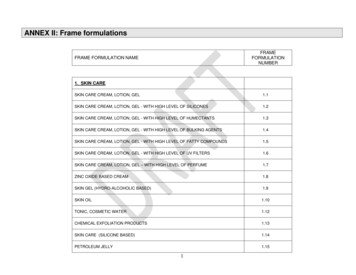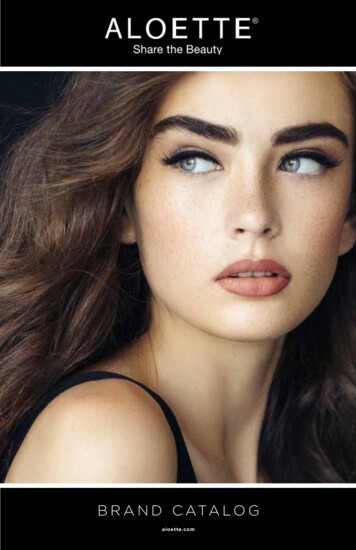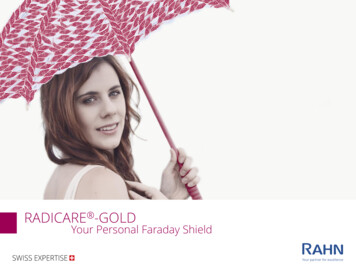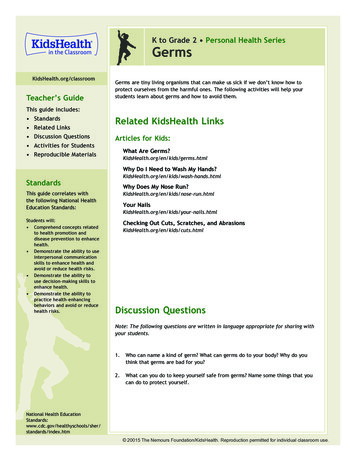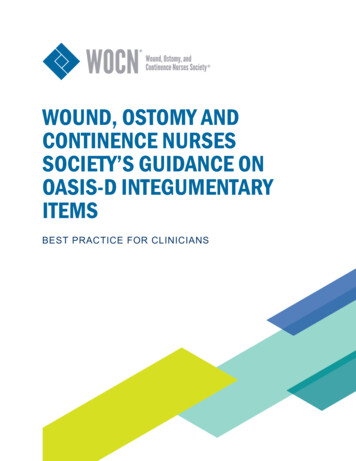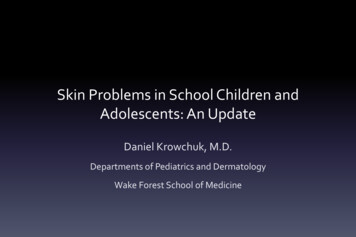
Transcription
Skin Problems in School Children andAdolescents: An UpdateDaniel Krowchuk, M.D.Departments of Pediatrics and DermatologyWake Forest School of Medicine
Round Things
Border well defined,elevated, and redScale
Tinea Corporis (Ringworm) Spread by direct contact,fomites, occasionally fromdogs or cats Treatment– Topical: miconazole,clotrimazole, others– Oral: griseofulvin, terbinafine
Tinea Corporis
-Border not elevated-Crust, not scale-No central clearing
Nummular Eczema-Variant of atopic dermatitis-Treated with an emollient andtopical corticosteroid
-Erythematousplaque (nocentral clearing)-Thick scale-Scalp involvement-Sharply marginatedPsoriasis
Bleeding at the siteof scale removal(Auspitz sign)Psoriasis Likely the result of agenetic predisposition andan environmental trigger(infection, trauma) Initial treatment is with atopical corticosteroid
-Ring and incompletecentral clearing-No scale-Border elevated andfirmDermAtlas
Granuloma AnnulareDermAtlas-Cause unknown-No treatment needed; resolvesspontaneously
DermAtlas
Erythema Migrans (Lyme Disease) Most common manifestation of Lymedisease (early localized stage) Begins as an erythematous papule ormacule that enlarges to 5 cm indiameter over days to weeks– Often develops central clearing– Center may be vesicular or necroticDermAtlas Treated with doxycycline ( 8 yrs) oramoxicillin ( 8 yrs)
http://www.cdc.gov/lyme/stats/maps/map2013.html
Hair Loss
Hair Loss Acquired vs. congenital Localized vs. generalized Nonscarring vs. scarring
“Black-dot” hair
Tinea CapitisInflammatory formSeborrheic form
Tinea Capitis: Treatment Oral medication:– Griseofulvin: 20 mg/kg/d of the microsize preparation for 8weeks– Terbinafine: 25 kg: 125 mg/d, 25-35 kg: 187.5 mg/d, 35 kg: 250mg/d for 4-6 weeks Selenium sulfide 1% or 2.5% used as a shampooevery other day for 2 weeks May return to school after treatment begun Return in 3-4 weeks to assess response totreatment
TractionSymmetrical hair lossat sites of tension onhairsKrowchuk DP, Mancini AJ, eds. Pediatric Dermatology. A Quick Reference Guide. 2nd ed.
Alopecia Areata-Complete or nearlycomplete hair loss-Scalp appears normal
HairPullingDisorder-Hemorrhage atsite of pulled hairs-Incomplete hair loss-Within affectedareas hairs are ofdiffering lengths
Light Spots
-Reduction (not totalloss) of pigmentation-Gradual transition fromnormal to abnormal color
Pityriasis Alba Postinflammatory hypopigmentation Often becomes more apparentafter sun exposure Treated with a low-potencytopical corticosteroid Pigment normalizes in months
Vitiligo-Loss of all skin color (i.e.,depigmented)-Sharp border betweennormal and abnormalcolor
Well-defined hypopigmented macules(i.e., sharp borders)
Tinea Versicolor-Superficial yeast infection-Affects adolescents and youngadults-Treated with selenium sulfidetopically (or fluconazole oritraconazole orally)
Seborrheic Dermatitis Inflammatory response tosuperficial yeast infection Treatment:DermAtlas– Scalp: antiseborrheic shampoo (e.g.,selenium sulfide, zinc pyrithione)– Skin: low-potency topicalcorticosteroid or topical imidazole
A 9-year-old girl has been treated twice with permethrin forhead lice. On examination you find lice and nits. Whattreatment might you advise?
DiagnosisViableegg Lice may be difficult to identifyCDC, Public HealthLibrary– Move quickly (6 – 30 cm/min)– Avoid light– May blend into surroundingsNymphabout toemerge– May be few in number (average 10) Viable eggs– Match hair color of affected individual (appearwhite when empty)– Usually located within 1 cm of scalpDeVore CD, et al. Pediatrics 2015;135:e1355-e1365Emptyegg
Using Permethrin Shampoo with a nonconditioning shampoo, rinse, toweldry Apply permethrin for 10 minutes then rinse Since 20% to 30% of eggs are not killed and eggs hatch in8-9 days (range 7-12 days) repeat treatment in:– 7-10 days (9 optimal based on life cycle of louse)– 7, 13-15 daysDeVore CD, et al. Pediatrics 2015;135:e1355-e1365
Second-Line TreatmentsDrugRx/OTCMechanism of ActionCostOvide (malathion)RxNeurotoxic1 132.99 for 2 oz2Sklice (ivermectin)RxNeurotoxic4 272.67 for 4 oz2LiceMD(dimethicone)OTC- Facilitates lice removal 13.99 for 4 oz3- May block respiratoryapparatusNatroba (spinosad)RxNeurotoxic4 178.55 for 4 oz2Ulesfia (benzylalcohol)RxParalyzes respiratory apparatus4 60.58 for 8 oz21potentially flammable2 goodrx.com, 2/12/153 drugstore.com, 2/12/154 approved for those 6 months of ageOral ivermectin- 200 mcg/kg once and again in 10 days- NOT FDA approved- Don’t use 5 years, 15 kg
Treatment Facilities Offer treatments on site or in your home Treatments employ combing combined with a topicalnonpesticide mousse or heat Cost: begins at 85
Heat for Head Lice Compared 6 heat-basedtreatment methods in 169subjects% LouseMortality% useBuster80.1(88.2)98(99.2)Air AlléGoates BM, et al. Pediatrics 2006;118;1962-1970Bush SE, et al. J Med Entomol 2011;48:67-72
Atopic Dermatitis-Erosion (fromscratching)-Lines of skin stress areprominent (lichenification)
Appearance
AppearanceDermAtlasErythema lessevidentEruptionpapular
Children and Adolescents
AdolescentsDermAtlas
AdolescentsDyshidrotic eczema:pruritic vesicles onsides of fingersDermAtlas
Epidermal Barrier Dysfunction- Increased penetration of allergensand irritants; bacterial colonization- Increased water loss, dry skin-Avoid irritants-Emollient-BreastfeedingImmune dysregulation- Abnormal cellular infiltrate andcytokine production initiate andperpetuate inflammation- Decreased antimicrobial peptides-Topical steroid-Bleach bathsGenetics- Mutations of genes coding epidermalStaphylococcus aureus- Cell wall components, superantigens,proteins (FLG) and cytokines (SPINK5)and enterotoxins amplify theinflammatory response
Rash in a Line
Contact Dermatitis: Poison Ivy
Fine erythematouspapulesLinear arrangement
Herpes Zoster
DermAtlasDermAtlasLesions at sites of trauma(Koebner phenomenon)Psoriasis
Rash All Over
Petechiaeon palateCDC Public Health Image Libraryhttp://phil.cdc.gov/phil/home.aspRash composedof fine, rough, redpapules
Scarlet Fever Infection with strains ofStreptococcus pyogenes thatproduce an erythrogenic toxin Begins with symptoms ofstreptococcal pharyngitis– Sore throat– Fever– Headache– Abdominal pain or nausea
Rash oftenconcentratedin skin flexuresDermAtlasErythema may beless noticeable inthose more deeplypigmented
Scarlet Fever - Treatment Amoxicillin: 50 mg/kg (max 1 g) once daily for 10 days Penicillin V bid-tid for 10 days:– 27 kg: 250 mg; 27 kg: 500 mg Benzathine penicillin G IM once:– 27 kg: 600,000 units; 27 kg: 1.2 million units Azithromycin or cephalexin if penicillin allergic
Erythema Infectiosum (Fifth Disease) Most common manifestation of parvovirus B19 infection Prodromal symptoms (low-grade fever, HA, and URIsymptoms) may be present Rash begins on the face (“slapped-cheek” appearance)with rapid spread to the trunk and extremities Rash resolves in 1-3 weeks but may return with sun orheat exposure, exercise
Erythema Infectiosum: Complications Arthritis: 60% of adolescents and adults Transient aplastic crisis: in those with sickle cell diseaseor other hemolytic anemia Fetal hydrops or demise:– Risk: 5% if not immune– Refer pregnant women exposed to parvovirus B19 to theirobstetrician
Pityriasis Rosea Clinical:– Patients usually well (5% have malaise, headache, sore throat)– Herald patch in 50-80%– 2-21 days later a generalized eruption occurs– Eruption lasts 2-12 weeks Treatment:– Antihistamine, topical corticosteroid, counterirritant (emollient with camphor ormenthol) for pruritus– UV light
Pityriasis RoseaDermAtlasScale attrailing edgeof lesion-Lesions usuallyoval-Aligned parallel tolines of skin stress
Pityriasis RoseaOn the back, the arrangement oflesions mimics the appearanceof the branches of a fir tree.
You are evaluating a child whohas fever, cough, conjunctivitis,rhinorrhea, and a generalizederythematous macular andpapular rash.M Rimsza
http://www.cdc.gov/measles/cases-outbreaks.html
http://www.cdc.gov/measles/cases-outbreaks.html
Measles Incubation: 8-12 days Prodrome: lasts 3-5 days,characterized by low-grade fever,cough, coryza, conjunctivitis Koplik spots:– Gray-white dots with surroundingerythema– Initially located adjacent to lowermolars– Appear 2-3 days after symptomsbegin (1-2 days before rash)– Resolve by day 2-3 of rash
Measles Exanthem Begins as faint maculeslocated along the lateralaspects of neck, hairline Spreads within a day toface, trunk, upperextremities By day 2-3, rash begins tofade on face and reachesfeet
Bumps
Molluscum Contagiosum Infection with theMolluscipox virus Spread by direct contact,fomites, autoinoculation Resolves spontaneously Lesions are translucentpapules that may have acentral umbilication
Molluscum ContagiosumDermatitisnear lesionsis commonAn enlarging, redlesion often is theresult of immuneactivation (notinfection)
Molluscum ContagiosumRememberthe Koebnerphenomenon?
When Will It Go Away? Mean time to resolution: 13.3 months– Lesions present in 30% of patients at 18 months, 13% at24 months In 41% of families with multiple children, one ormore other children were affectedOlsen JR, et al. Lancet Infect Dis 2015;15:190-195.
Treatment Options No intervention Tretinoin Cantharidin Salicylic acid Cryotherapy Topical corticosteroid if Curettage Imiquimodsurrounding dermatitis
Unproven TherapiesMarkum E, Baille J. Combination of essential oil ofMelaleuca alternifolia and iodine in the treatment ofmolluscum contagiosum in children. J Drugs Dermatol2012;11:349-354.
-Rough surface-Thrombosedcapillary
WartsPeriungual WartPlantar WartsSlide Atlas of Pediatric Physical Diagnosis
WartsCommon WartsDermAtlasFlat Warts
Treating Common or Plantar Warts Keratolytic (cure rate: 75% [48% forcontrols]) Cryotherapy (cure rate: 80% in 12weeks after 2-4 treatments) Cantharidin Imiquimod (Aldara)
Using Keratolytics Apply medication to wart and allow to dry Cover with Band-Aid or tape In the morning (or in 24 hours) wash the area and dry Using an emery board or pumice stone, debride the wart Repeat above steps
Crusted Rashes
Crusted Impetigo Cause: infection with Staphylococcus aureus Clinical: erosions with a “honey-colored” crust typicallylocated around the nares Treatment:– Topical: mupirocin (Bactroban), retapamulin (Altabax)– Oral: first-generation cephalosporin (e.g., cephalexin),trimethoprim-sulfamethoxazole, clindamycin
Remnant ofscaleErosion
Bullous Impetigo Cause: infection with S. aureusstrains that produce anepidermolytic toxin Clinical: vesicles or bullae ruptureleaving round or oval erosions Treatment: first-generationcephalosporin (e.g., cin
Slide Atlas of Pediatric Physical Diagnosis Periungual Wart . Warts Common Warts Flat Warts DermAtlas . Treating Common or Plantar Warts Keratolytic (cure rate: 75% [48% for controls]) Cryotherapy (cure
